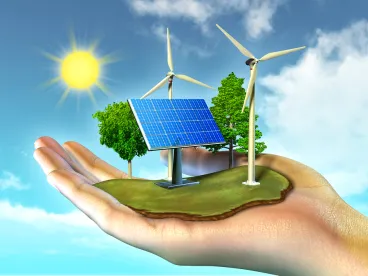COVID-19’s rapid spread has brought severe disruption and uncertainty to the supply chain for wind, solar and energy storage, as well as the project finance market. While the speed and complexity of COVID-19 make it impossible to know the full effects the virus will ultimately have on the world, we offer a real-time update of what we know today and a list of legal and commercial action items to be taken while we continue to monitor the governmental response to the economic impacts of COVID-19 and the availability of tax equity and debt financing.
IN DEPTH
The world is facing a situation unprecedented in modern times with the global spread and impact of the Coronavirus (COVID-19). COVID-19’s rapid spread has brought severe disruption and uncertainty to everyone’s personal lives, as well as to the wind, solar and storage industry supply chains, the renewable project financing market, and global markets at large. While the speed and complexity of the virus make it impossible to know the full effects it will ultimately have on the world, what follows is what we know today about the impact of COVID-19 on the supply chain for solar, energy storage and wind developers, as well as the project finance market.
COVID-19’s Impact on the Wind Turbine Supply Chain and Tax Credit Strategy
Wind developers are experiencing both immediate supply chain disruptions and potentially dramatic impacts of delay on construction timelines and financings.
In the best of times, 2020 was already an especially critical year because it is the last year for US developers to complete projects that qualified for the full Production Tax Credit under the four-year “safe harbor” guidelines for projects that commenced construction in 2016. As a result, even a minor delay may put the projects at risk of missing the 2020 deadline, threatening the project’s economics.
Prior to the COVID-19 disruptions, there was already a tight supply of key components such as turbine blades and main bearings. Even though most production of wind turbine components occurred outside of Hubei, the Chinese quarantine and travel restrictions impacted all Chinese manufactured goods. Since the disruptions have occurred, wind turbine suppliers have provided force majeure notices to most utility-scale wind developers (for more on force majeure, see our recent On the Subject “Force Majeure and COVID-19: Frequently Asked Questions“). These supply chain disruptions may be on top of delays due to crane or other construction equipment availability and, now, the risk of worker availability at the project sites due to the effects of COVID-19 in the United States. We have already seen a large number of turbine suppliers issue notices of force majeure. We are beginning to see construction force majeure claims declared and expect to see more in the coming days.
Next Steps:
-
Because of the immediate impact of both the time and effect of COVID-19 delays, it is critical that wind developers continue exploring their options for their projects. This review should begin with a review of force majeure clauses in turbine supply agreements and construction contracts, but should extend to a review of the force majeure protections that the Project has in its offtake agreements.
-
There are various tax incentive proposals being discussed, including one to extend the PTC continuity safe harbor from four to six years for projects commencing construction in 2016, 2017, 2018 and 2019, and to secure a direct pay provision equal to 100% of the PTC value to address expected decreases in the availability of tax equity. We are actively engaged in these PTC proposal discussions with both our clients and the US government, and regardless of the outcome of these proposals, it will be important for developers to consult with tax counsel on the front lines of these changes to discuss options to protect each project’s tax credit economics.
COVID-19’s Impact on Solar Panel Procurement and Tax Credit Strategy
As a result of the solar tariffs put in place by the Trump administration, the US solar market is likely to be less impacted by COVID-19 than other major markets throughout the world. As a result of these tariffs, most panels used in the United States still come from Chinese vendors but they are now most-often manufactured in South East Asian countries. These countries have not faced the same impacts from COVID-19 as faced by manufacturing facilities in China, so there has not been as immediate a disruption to the supply chain for solar facilities.
While South East Asian panels are often built from raw materials sourced from China, any effect upon raw material availability is more remote and may more be more easily overcome than the impact of manufacturing reductions in China. Further, the effect upon the US solar supply chain, though likely to occur at some level, is not as immediate a threat to developers as other COVID-19 impacts. As such, those developers expecting to receive solar panels in the medium-term should thoughtfully prepare now for a potential reduction in panel availability either due to a short-term blip in raw material availability or a larger impact on South East Asian manufacturing.
Next Steps:
-
Today’s landscape for panel procurement and tax credit strategy is quickly shifting. Developers should consider their options now regarding panel procurement, project schedule, and tax credit and module safeguarding strategy.
-
Similar to the PTC tax incentive proposal discussed above, there are various tax incentive proposals to extend the ITC continuity safe harbor from four to six years for projects commencing construction in 2016, 2017, 2018 and 2019, and to secure a direct pay provision equal to 100% of the ITC value to address expected decreases in the availability of tax equity. Developers should consult with tax counsel leading the discussions of these ITC changes to discuss options to protect each project’s tax credit economics.
-
With the effects of COVID-19 disruptions now in the United States, we expect to see more force majeure notices provided by construction and other companies. Developers should prepare now by reviewing their options in respect to force majeure.
-
Certain solar panel manufacturers operate at small margins and may be especially at risk of a loss of profits from a longer-lasting global economic impact arising out of the COVID-19 pandemic. Developers should assess the creditworthiness of their panel manufacturers and implement alternative procurement strategies with suppliers that are more certain to weather any forthcoming economic downturn and fulfill their commitments.
COVID-19’s Impact on Energy Storage Procurement and Pricing
Historically, the global energy storage market has depended upon manufacturing in both China and South Korea. However, a recent increase in South Korean incentives has caused local manufacturers to shift more of their sales to their domestic markets, which has led to a greater reliance upon Chinese battery manufacturers. More than 60% of China’s battery storage manufacturing was located in Hubei and surrounding provinces, where the virus outbreaks originated and were felt most strongly.
Prior to the onset of COVID-19, Wood Mackenzie estimated that US energy storage rose 523 MW in 2019 and could triple to 1452 MW in 2020 and then double to 3646 MW in 2021. Recent estimates are that China’s battery storage production capacity will decrease by at least 10% in 2020. This will have a major carryover effect on the ability of developers to purchase battery cells in the coming year and is likely to cause delays in receipt of orders or an increase in price for these batteries. The brunt of these delays will be borne by the electricity market and the electric automobile market, but there is also a carryover effect on consumer electronics and other users of lithium-ion batteries.
Next Steps:
-
Although recent reports are that Chinese manufacturing facilities are beginning to ramp up production, there is certain to be an impact upon battery storage availability in 2020. While this will certainly impact a number of US developers, the impact may be reduced by the lack of looming tax credit or other regulatory deadlines, which may allow some projects to be postponed or the inclusion of energy storage in a project to be reduced.
-
Developers would be well suited to closely monitor the forthcoming increase or decrease in production and the resulting effects on storage pricing. In addition, they may be well served to evaluate their battery procurement strategies in light of certain tax incentives proposals that could extend to battery storage.
-
The US storage industry is currently pushing for a full ITC cash grant for storage as part of any stimulus package. We will continue to monitor these proposals.
COVID-19’s Impact on Project Financing
As governments and the Federal Reserve have taken steps to slash interest rates and ease bank rules, this may have an effect on the availability of debt financing. With lower interest rates, refinancing projects—in addition to the demand for financing new projects—should become a priority for sponsors. However, this demand is likely counteracted by lenders who will have a lower appetite for providing these loans when they provide less profit on lower interest rates. Further, additional uncertainty around a potential recession and credit crunch is also playing a role in diminishing loans. It is impossible to read the news without finding a new article about a different industry that will face major bankruptcy risk in the near future if the COVID-19 situation remains unchanged or a new prognosticator suggesting a recession is on the horizon. Anecdotally, we have been told that some lenders have already modified their internal requirements to provide greater scrutiny of potential loans.
We are also seeing a negative impact on the availability of tax equity financing. Some traditional tax equity investors are showing concern about how much income tax they will have the ability to shelter if a recession occurs. Also, uncertainty around government stimulus packages and their effects upon a tax equity provider’s tax responsibilities may also cause a short-term reduction in the availability of tax equity financing.
The effects of COVID-19 are unprecedented, and it is difficult to definitively ascertain at this time what the results will be on the availability of debt and tax equity financing. We think it is likely we will see project financing remain stable or undergo a quick bounce-back, as occurred in the 1987 recession. Long-term offtake arrangements and existing tax equity incentives help buffer the majority of projects from market spikes in the near term. Additionally, the potential tax incentive proposals and economic stimulus packages may even give a boost going forward. A less likely alternative, in our view, is that we see a more extended disruption as occurred in 2009. We have not yet seen any indicators of a liquidity crunch like we saw back then.
Next Steps:
-
Conduct a project (or portfolio) level of review for project risks that are exacerbated by COVID-19. Under normal circumstances, projects face risks related to supply chain risk, completion delay risk and change order risk. With COVID-19, each of these risks are heightened while labor risk and potentially stricter lending and funding criteria are introduced.
-
Conduct a critical review of all project, financing and acquisition documents. Under normal circumstances, owners/borrowers must remain diligent complying with the numerous obligations contained in their agreements, particularly financing agreements. With COVID-19, there are likely certain repayment covenants, information covenants, events of default and material adverse effect/change items that could be triggered indirectly due to cross-defaults under the project documents or directly due to the virus’ impact on the economics of the project.
-
Consider any impacts or developments with government meetings cancelled; and with the general concern about person-to-person contact, we may see delays in permits, reports and even obtaining leases from landowners. This should be given careful scrutiny by developers.
Conclusion
COVID-19’s rapid spread has brought severe disruption and uncertainty to the wind, solar and storage industry supply chains, and the renewable project financing market. We continue to monitor the governmental response to the economic impacts of COVID-19 as well as the availability of tax equity and debt financing. In particular:
-
We are continually monitoring governmental reactions, and as stimulus packages are deliberated and passed, we remain prepared to counsel renewable developers and financiers in regards to any potential impact or available opportunities that they present.
-
While we recognize that quarantines have caused much global manufacturing to shut down, we do not yet know the magnitude of the impact the loss of electricity demand and revenues will have on renewable energy producers. As we receive news of these reductions, we remain prepared to counsel projects with both variable rate offtake agreements and new projects that are in negotiation with offtakers.
-
We continue to watch how the tax equity and credit markets adjust the availability of funds and the terms upon which they are offered as the virus hits new markets daily. We remain prepared to counsel projects on the state of the market and the latest market terms.








 />i
/>i

